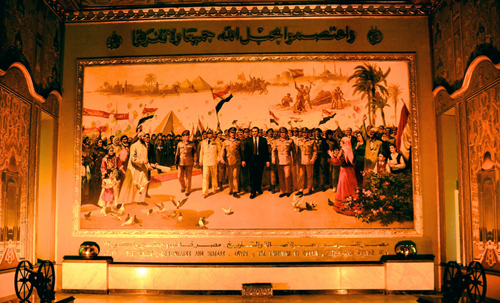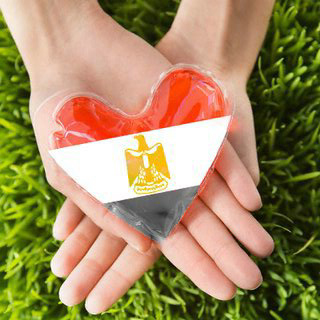
Cairo International Airport, Terminal 1, January 30, 2011. Photo by Alex Freedman.
On January 31, BA177 hummed with mixed messages. Tourists who’d been vacationing in Cairo’s International Airport sighed with relief. Evacuated expats who left their homes doubled up on tiny vodkas. Several Egyptians heading out on tickets booked long in advance chatted with nervous hope about the revolution’s success. And in first class, an Egyptian family of three sat comfortably, having sped directly up to the airplane, bypassing the marathon queues that could only be described as inevitable in an airport armed on security-lite.
To counter protesters’ tenacity, the government had shutdown the Internet, the curfew had moved from 4 to 3pm, tanks had rolled into residential areas, plainclothes police offers were sparking mayhem, and fighter jets had been released over Tahrir. Concentrated on the octogenarian control freak in question, my thoughts turned to the Egyptian Military Museum and a work no one needs to be tweeting about: the mammoth painting of Hosni surrounded by parades, pyramids, and the most romantic looking pigeons ever painted by anonymous North Koreans. Letting go, I imagined the museum’s curator going rogue and burning the work as a performative gesture in celebration of Egypt Rising: Part Let My People Go, and laughed out loud wondering: had it really been only a week since I told one of my students that if she wanted to set fire to her paintings to voice her frustrations that I wouldn’t think it Haraam?

Hosni Mubarak in Abdeen, unknown North Korean painter, ca. 1993. Photo by Alex Freedman.
Last month, Lindsay Lawson and I directed a weeklong intensive Internet art and professional skill-building workshop, Future Tense, for a group of young Egyptian artists-in-residence at MASS-Alexandria, a new space opened by Wael Shawky last November. At the time, I joked that we’d fulfilled the government’s paranoid delusion that American elements were out to alter young minds, and in hindsight it seems almost too ironic that Future Tense began as Tunisia’s Ben Ali fled to Saudi Arabia and wrapped up as Egyptians took to the streets. MASS-Alexandria’s inaugural residents are typical young artists: creative producers searching for a means to articulate themselves, the world, and the future, falling short at times and succeeding at others. But alongside the universal questions young artists wade through was their inspiringly collective desire to conceptually dwarf what they’d seen and made before. To acquire the means to renew art, their educational system, their communities, and their country. Coming into it, I never imagined that a group of ten predominately hijab-donning women, would open up so immediately, and so actively engage questions of desire, power, abuse, self, and sexuality. Or even more surprisingly, attentively critique statements in a second language six hours a day for a week straight.

Baroque reproduction chairs, found image
Though in their nascence, their ideas are a credit to the momentum of possibility pulsing through Egypt right now: glitch; abject art in a sexually closed society; the government’s role in perpetuating anti-semitism; young women’s rights to personal independence; the role of engineering in urban decay; the origin of police violence; and Egypt’s national exchange of meaningful ideas for cheaply fabricated aesthetics, which allude to grandeur. If there ever was or will be an experience that confirms my belief that experimentation is the only route to salvation, it was co-teaching Future Tense on the eve of a revolution.
For those uninitiated with Egyptian higher arts education, We Make Money Not Art summed it up pretty succinctly as, “In Egypt there is a rift between institutions founded by the government and independent ones. Art students are advised not to attend arts events organized by independent art institutions and galleries. Video and photography are not even taught.” With select exceptions, such as the Youth Salon’s 20th edition, one look around the Cairo Biennale, and yearly youth salons, it’s obvious that government-run institutions fear unrestrained artistic production. Typically, younger artists working in sound, performance, installation, video, photography, and computer programs are self taught, educated abroad or active in workshops programmed at independent spaces like Alexandria Contemporary Arts Forum (ACAF), Contemporary Image Collective (CIC), MASS-Alexandria, or Townhouse. Spaces run by curators and artists, who, in addition to creating their own work, have been charged with educating a new generation of artists out of formal impoverishment.
But in a turn of incredible inspiration, only three weeks after ACAF’s Artistic Director and Manifesta 8 curator Bassam el Baroni told me that in order to create a milieu ripe for concept-driven artistic production, Egypt’s social systems must be overhauled, it seems that creative producers will get the chance. In that regard, it is all the more tragic that Ahmed Basiony, an artist and professor at Helwan University who died protesting on January 28, won’t be here to take part. But if the outpouring of emotion on Basiony’s memorial page and on the others who have died in the past two weeks are a barometer for newly minted social engagement, then while these individuals will be sorely missed, their deaths have triggered a sense of responsibility in so many others to take up what they left behind.
In leaving Cairo, especially before media sources bluntly reported on Mubarak’s power wrestle-mania, it has been difficult to adequately convey to family, friends, and fellow tourists that what we are witnessing is a government creating lawlessness to save itself against our better interest. Yes, I did see some protesters burn buildings like the National Democratic Party, but the aura of violence and concern for my personal safety emanated from the security forces. They were the ones who turned the Nile into an echoing tunnel of live ammo, made the city reek of ramen microwaved in melted plastic (tear gas), cut off lines of communication, and, as it turns out, aided and abetted the release of imprisoned criminals and the looting of business.
Before the police retreated and the army was deployed, young police men in riot uniforms stood at attention, ready to throw tear gas, shoot rubber, or beat flesh when ordered. Yet their adherence to violence shouldn’t be misconstrued as something inherent — it is really yet another casualty of an identifiable system which has corrupted its youth in exchange for civil obedience. The branch, which includes riot police, is made of conscripts, often barely literate, who are pulled for three years from their impoverished towns and inculcated. One can only speculate what these young men would do and believe if they had been given an adequate education to think critically for themselves. In turning our attention to the taxonomies of violence ripping through Egypt in the past two weeks — and I say this as someone whose name is the Jewish-American version of John Smith — it is worth considering how the Middle East, the US, and Europe would benefit from an educated Egypt, one which is not headed by a fear mongering autocrat gone mad.
[youtube:https://www.youtube.com/watch?v=U94PCrdHG4w]
On my final walk through Tahrir, and alongside the Ministry of the Interior (the building from which plainclothes officers were shooting demonstrators), looking past the looted buildings and burnt autos, none of which can be easily attributed to a responsible party, what I saw were people holding discussions, distributing food, volunteers cleaning up the debris and water left over from the water cannons, and medics aiding the injured. In the days since, as I’ve followed Townhouse curator Sarah Rifky‘s and other friends’ feeds about the massacring of demonstrators by paid Mubarak supporters, and demonstrators’ ability to organize medical supplies and haircuts, while developing ideas about what comes next for a movement that is just beginning, I am reminded of a bizarre confrontation I had three years ago when an Iraqi War veteran threateningly stabbed a magazine to death when I asserted that arts and educational funding is more vital than intervention. The conclusion I came to then: if the ability to conceive of new worlds is what frees us, then conceptual thinking is our only recourse.





Pingback: Tweets that mention Egypt Rising | Art21 Blog -- Topsy.com
Pingback: VeniceЯUs | Art21 Blog
Pingback: VeniceЯUs - 1-954-270-7404
Pingback: Venice and Us | Your Pure Art
Pingback: Venice Bienalle 2011 in Pics | Your Pure Art